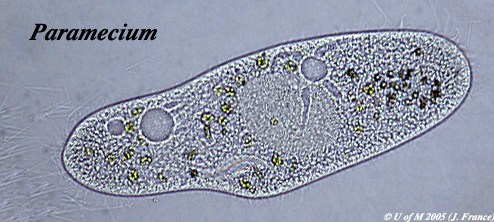
 |
Protista
(Canadian Campbell Chapter 28)
The Kingdom Protista includes all organisms having eukaryotic cells and based on the unicellular or single celled body plan. The group includes some organisms which show plant affinities as well as others which show clear relationships to animals. The animal-like protists are referred to as the protozoa and some texts would place these organisms in a phylum (Protozoa) within the animal Kingdom. We will be considering them in the same way of Campbell, as several among many separate phyla within the Kingdom Protista.
Animal-like protists (protozoans) are a large and diverse group of organisms found in fresh, marine and brackish waters; in hot springs, salt pools, acidic bogs, soil, sludge and sewage. Many live as parasites, some of which cause serious disease in animals, including humans.
We will examine only two of the many Phyla:
Supergroup Unikonta
(Amoeboid Protozoans)
(Canadina Campbell Concept 28.5)
Organisms found in this phylum move and feed by means of cellular extensions called pseudopodia. Amoeba proteus is an example that is commonly found in freshwater habitats, where it feeds primarily on other protozoans. When an amoeba moves, it extends a pseudopodium and anchors the tip. Differences in concentration gradients lead to more cytoplasm streaming into the pseudopodium, and the amoeba moving.
Click to view a quick-time move of Amoeboid motion

The following questions sould be answered using your lecture notes, text and lab observations:
Supergroup SAR - Ciliates
Canadian Campbell Page 639-640

This diverse group of organisms move and feed by way of short cellular appendages called cilia and are mainly freshwater in nature. Cilia can be arranged in specific ways, which helps species to adapt to their lifestyle. Paramecia are common freshwater protozoans usually found associated with decaying vegetation where they feed on bacteria and smaller protozoans.
Examine
the Paramecium at low magnification
Examine
a prepared slide of Paramecium
You should note the patterns of locomotion from the pond culture obtained in lab. Three distinct locomotory pattern should be apparent: forward, rotating and swerving.
Sketch a Paramecium to show general body form. On the sketch indicate the macronucleus, micronucleus, oral groove, gullet, contractile vacuoles and cilia. You will need to view both the living and prepared materials to observe all of these structures.
![]()
